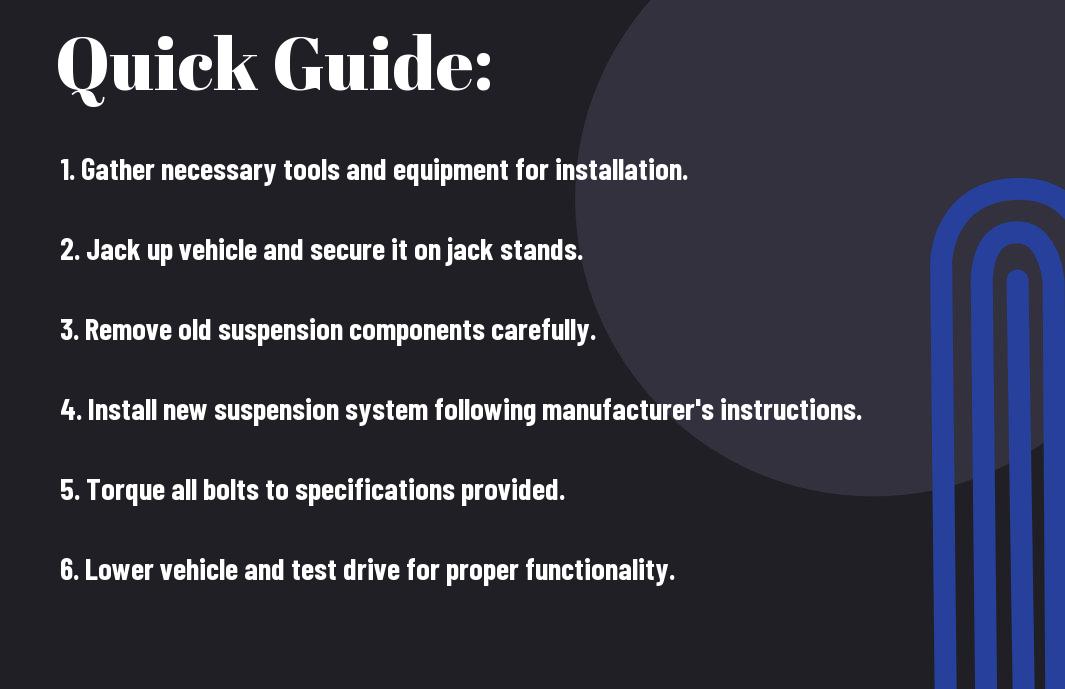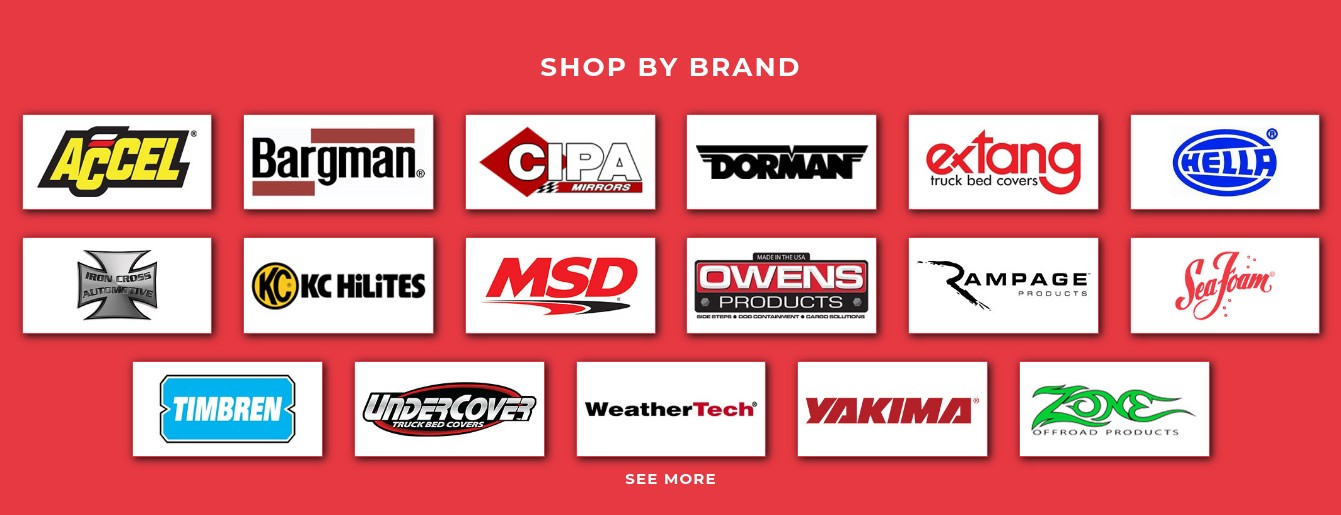Delve into the world of vehicle upgrades with this DIY guide on installing suspension systems at 4 Wheel Parts McAllen. As a crucial component of your vehicle, the suspension system plays a vital role in ensuring a smooth ride and handling. It is important to tackle this task with caution and precision to reap the benefits of improved performance and off-road capabilities. Our step-by-step guide will empower you to take control of your vehicle’s enhancement process and walk you through the intricacies of installation.

Types of Suspension Systems
Some important aspects to consider when choosing a suspension system for your vehicle include the type of driving you will be doing, the level of comfort you desire, and the terrain you will be encountering. Here are some common types of suspension systems you can choose from:
| Standard Suspension Systems | Performance Suspension Systems |
| Coil Spring Suspension | Adjustable Suspension Kits |
| Leaf Spring Suspension | Lowering Suspension Kits |
| Gas Shock Absorbers | Lift Kits |
| Independent Suspension | Coilover Systems |
| Control Arms | Performance Shocks |
Standard Suspension Systems
Any vehicle comes equipped with a basic suspension system that includes standard components such as coil spring suspension, leaf spring suspension, gas shock absorbers, independent suspension, and control arms. These suspension systems provide a comfortable ride for everyday driving and are ideal for drivers who do not require enhanced performance.
When considering a standard suspension system, keep in mind that these systems are designed to meet the basic suspension needs of a vehicle. Upgrading to a performance suspension system may be necessary for those seeking improved handling and overall performance.
Performance Suspension Systems
Systems with performance suspension systems feature more advanced components and are designed to enhance a vehicle’s handling and overall performance. These systems include adjustable suspension kits, lowering suspension kits, lift kits, coilover systems, and performance shocks. Performance suspension systems are ideal for off-road enthusiasts, racers, and drivers looking to improve their vehicle’s performance capabilities.
The key to a performance suspension system lies in its ability to provide superior handling, increased stability, and improved cornering. Drivers who demand more from their vehicles can greatly benefit from the enhanced capabilities that performance suspension systems offer.
Performance Suspension Systems: When upgrading your vehicle’s suspension system, it is essential to consider the various factors that can impact performance and ride quality. By understanding these factors, you can make an informed decision when selecting the right suspension system for your vehicle.
Factors to Consider When Choosing a Suspension System
Suspension system components play a crucial role in a vehicle’s performance and overall ride quality. When choosing a suspension system, consider the following factors:
- Driving Conditions: Determine if you will be driving primarily on or off-road.
- Vehicle Type: Consider the make and model of your vehicle.
- Performance Needs: Assess your desired level of handling and performance.
- Budget Constraints: Determine how much you are willing to spend on a suspension system.
Recognizing these factors will help you select a suspension system that meets your specific needs and requirements. Whether you prioritize comfort, performance, or off-road capabilities, choosing the right suspension system is essential for a smooth and enjoyable driving experience.
Tools and Materials Needed
Despite the complexity of installing suspension systems, having the right tools and materials can make the process much smoother. From basic hand tools to specialized suspension tools and safety equipment, this DIY guide will ensure you are well-equipped to tackle the job.
Basic Hand Tools
Tools such as wrenches, sockets, screwdrivers, and pliers are essential for the installation process. These common tools will be used for tasks such as removing old suspension components, tightening bolts, and adjusting various parts of the new system. Having a complete set of these tools will ensure you have everything you need at your fingertips.
Additionally, a hydraulic jack and jack stands will be necessary for raising the vehicle safely off the ground. These tools are crucial for providing a stable working environment and ensuring the vehicle remains secure while you work on it.
Specialized Suspension Tools
Tools such as spring compressors, ball joint separators, and torque wrenches are specialized equipment required for working on suspension systems. These tools are designed specifically for suspension work and are essential for safely and effectively installing new components. While they may not be found in every toolbox, investing in these tools will make the job much easier and safer.
Materials like lubricants, anti-seize compounds, and thread lockers are also important for the installation process. These materials help prevent corrosion, ensure smooth operation of moving parts, and provide added security for critical connections. Using the right materials can significantly extend the life of your suspension components.
Safety Equipment
One essential piece of safety equipment for working on suspension systems is a pair of protective gloves. These gloves will help prevent cuts, scrapes, and burns while handling sharp or hot components. Additionally, safety glasses are crucial for protecting your eyes from debris and chemicals that may be encountered during the installation process.
Any experienced mechanic will also recommend the use of a sturdy pair of steel-toed boots to protect your feet from heavy objects that could fall during the installation. Safety should always be the top priority when working on any automotive project.
Preparation for Installation
Vehicle Inspection and Assessment
After you have selected the perfect suspension system for your vehicle from 4 Wheel Parts McAllen, the first step is to perform a thorough vehicle inspection and assessment. This involves checking the condition of your current suspension components, tires, and other critical parts that may affect the installation process. Look for any signs of wear, damage, or rust that could potentially cause issues during installation.
The vehicle inspection and assessment is crucial to ensure that your suspension upgrade will be done correctly and safely. Identifying any existing problems before starting the installation will save you time and hassle in the long run.
Workspace and Vehicle Preparation
The workspace and vehicle preparation are essential for a smooth installation process. Make sure you have a well-lit and spacious area to work in, with all the necessary tools and equipment readily available. Clean the work area and ensure that the vehicle is parked on a flat, level surface.
Before starting the installation, it is also a good idea to gather all the required parts and read through the installation instructions provided by 4 Wheel Parts McAllen. Familiarize yourself with the steps involved and make a plan for how you will tackle the installation process.
Vehicle preparation is key to a successful installation. Ensure that your vehicle is in good working condition, with all necessary parts and tools on hand before you begin the installation process.
Planning Your Installation Strategy
Preparation is key when it comes to planning your installation strategy. Take the time to outline the steps involved in installing the suspension system, including any potential challenges or complications that may arise. Consider enlisting the help of a friend or family member to assist with the installation process.
By planning your installation strategy carefully, you will be able to streamline the process and avoid any unexpected setbacks. Remember, safety should always be your top priority when working on your vehicle.
Vehicle inspection, workspace preparation, and strategic planning are all crucial steps in ensuring a successful suspension system installation at 4 Wheel Parts McAllen. Take the time to prepare adequately before starting the installation process to make the job easier and safer.
Step-by-Step Installation Guide
Now, if you’re looking to enhance your off-road performance with a new suspension system, look no further than Toys For Trucks – Truck & Jeep Off-road Parts & Accessories for all your upgrade needs. Installing a suspension system can greatly improve your vehicle’s capabilities on rough terrain.
| Removing the Old Suspension System | Installing the New Suspension System |
Removing the Old Suspension System
Any suspension upgrade starts with removing the old components. Begin by safely lifting the vehicle using a jack and jack stands. Make sure to secure the vehicle properly before starting any work. Remove the wheels and then proceed to disconnect the shocks, springs, and other components from the vehicle.
Next, unbolt the control arms and sway bars, being careful to keep track of all hardware and brackets. Once all the old components are removed, take the time to clean and prep the mounting points for the new suspension system.
Installing the New Suspension System
Safely installing the new suspension system involves following the manufacturer’s instructions step by step. Ensure that all components are properly aligned and torqued to the manufacturer’s specifications. Begin by installing the new shocks and springs, then move on to the control arms and sway bars.
Pitfalls to avoid during installation include not torquing bolts to the correct specifications, misaligning components, and skipping steps in the installation process. Proper installation is crucial for the safety and performance of your vehicle.
Fine-Tuning and Adjustments
Avoiding any issues with your new suspension system involves making fine-tuning adjustments after installation. Check for any signs of alignment issues, strange noises, or excessive bouncing that may indicate a problem. Make adjustments as needed to ensure everything is functioning as it should.
With proper maintenance and care, your new suspension system will provide improved off-road performance and a smoother ride. Regular inspections and adjustments will help keep your vehicle in top condition for all your off-road adventures.
Pros and Cons of DIY Suspension Installation
Installing a suspension system on your vehicle can be a rewarding experience, but it also comes with its own set of challenges and considerations. Not every enthusiast may be up for the task of a DIY suspension installation, so it’s important to weigh the pros and cons before deciding to take on the project.
| Pros | Cons |
| Cost-effective | Time-consuming |
| Develop new skills | High risk if done incorrectly |
| Customization options | Void warranty if not installed by professional |
| Sense of accomplishment | Difficulty level varies by vehicle make and model |
| Learn more about your vehicle | Need for specialized tools |
| Flexibility to adjust as needed | May encounter unforeseen challenges |
| Availability of online resources | Lack of professional guidance |
| Opportunity to bond with your vehicle | May not meet manufacturer specifications |
| Pride in completing the project | Long-term impact on vehicle performance |
| Empowerment and independence | Risk of injury if safety precautions not followed |
Advantages of DIY Installation
Installation of a suspension system at 4 Wheel Parts McAllen store, especially if you’re from Texas, 4 Wheel Parts Stores in Texas, can be a fulfilling experience. Learning about the different components of your vehicle and how they work together can enhance your overall understanding and appreciation for your off-road machine. It also provides an opportunity to customize your suspension system to suit your specific needs and preferences. The hands-on approach allows you to take pride in your work and build confidence in your DIY skills.
Potential Drawbacks and How to Mitigate Them
Installation of a suspension system can be a complex and challenging process, especially for beginners. It requires a significant time commitment and attention to detail to ensure everything is installed correctly. Some potential drawbacks include the risk of voiding your vehicle’s warranty if the installation is not done by a professional, as well as the possibility of encountering unforeseen challenges along the way. To mitigate these risks, it’s essential to thoroughly research and prepare for the installation, seek guidance from experts or online resources, and take necessary safety precautions to prevent accidents or injuries.
Cons of attempting a DIY suspension installation include the potential for costly mistakes, such as improper installation that could lead to vehicle damage or compromised safety. Without proper knowledge and experience, DIYers may struggle to achieve optimal performance from their suspension system, impacting the overall handling and stability of the vehicle. However, with careful planning, proper tools, and a methodical approach, many of these challenges can be overcome to successfully install a suspension system that enhances your off-road adventures.
Are Truck Bed Covers Compatible with Suspension Systems for Off-Roading?
Yes, top truck bed covers can be compatible with suspension systems for off-roading. Many manufacturers design their truck bed covers to be compatible with off-road suspension systems, ensuring that the cover remains secure and functional even in rugged terrain. It’s important to choose a cover that is specifically designed for off-road use.
Maintenance Tips for Your New Suspension System
Keep your suspension system in top condition with these maintenance tips:
- Regularly inspect the shocks and struts for any signs of leakage or damage.
- Check the bushings and mounts for wear and tear.
- Ensure proper alignment after installation.
- Keep all components clean and free of debris.
- Follow the manufacturer’s guidelines for maintenance intervals.
Perceiving any issues early on can help prevent costly repairs down the line.
Regular Inspection and Care
Your suspension system plays a crucial role in your vehicle’s performance and safety. Regular inspection and care are essential to ensure optimal functionality. Inspect your suspension components regularly for any signs of wear and tear. Pay close attention to the shocks, struts, and springs for leaks, cracks, or other damage. Additionally, monitor the bushings and mounts for any signs of wear.
When to Seek Professional Help
Help from a professional may be necessary if you notice any of the following warning signs: unusual noises coming from the suspension system, a rough or bumpy ride, uneven tire wear, or a noticeable decrease in handling performance. Ignoring these signs can lead to further damage and compromise your safety on the road. If you are unsure about the condition of your suspension system, it is best to seek the expertise of a professional technician.
Final Words
Summing up our DIY Guide on Installing Suspension Systems at 4 Wheel Parts McAllen, it is clear that with the right tools, knowledge, and attention to detail, installing a suspension system can be a feasible task for any off-road enthusiast. By following the step-by-step instructions provided in this guide, you can confidently upgrade your vehicle’s suspension system and enjoy a smoother and more capable ride on and off the road. Remember to always prioritize safety and consult with professionals if you encounter any challenges during the installation process. Happy off-roading!





0 Comments